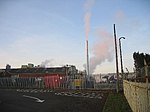Dinmore Tunnel
England rail transport stubsRailway tunnels in EnglandTunnels in HerefordshireUse British English from August 2016

Dinmore Tunnel is the name given to two railway tunnels located on the former Shrewsbury and Hereford Railway (S&HR) line between Hereford station and Leominster station. The first tunnel (currently the 'up' tunnel) was built in 1853, with the second tunnel (the 'down' tunnel) being added in 1891. Both are still in use and are jointly the 15th longest tunnels on the former Great Western Railway. To the south of the tunnel was Dinmore railway station, which closed in 1958. They are located just south to the village of Hope Under Dinmore and tunnels under Queen's Wood Country Park & Arboretum.
Excerpt from the Wikipedia article Dinmore Tunnel (License: CC BY-SA 3.0, Authors, Images).Dinmore Tunnel
Geographical coordinates (GPS) Address Nearby Places Show on map
Geographical coordinates (GPS)
| Latitude | Longitude |
|---|---|
| N 52.15699 ° | E -2.71555 ° |
Address
HR1 3JP
England, United Kingdom
Open on Google Maps








